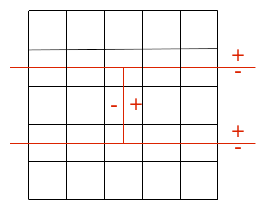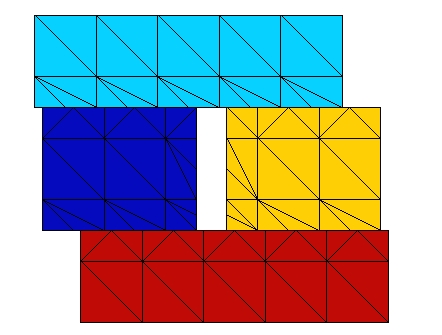7. E modeling#
7.1. Characteristics of modeling#
It is the same modeling as modeling A.
7.2. Characteristics of the mesh#
The mesh, which comprises 25 cells of the QUAD4 type, is represented in FIG. 7.2-a. The mesh is less refined than that of modeling A, so that some elements see the two horizontal cracks.

Figure 7.2-a: The modeling mesh E.
7.3. Features tested#
As for the other models, the vertical crack connects to the two horizontal cracks, but some elements see the 3 cracks.
Even if it is possible to connect crack 3 to cracks 1 and 2, it is not possible locally i.e. the algorithm put in place can only attach crack 3 to one other crack within the same element: there is therefore confusion between cracks 1 and 2.
To solve this problem, the user is forced to link crack 2 to crack 1 using the JONCTION keyword in DEFI_FISS_XFEM. Fissure 3 will therefore be explicitly linked to crack 2, which is linked to the first. Fissure 3 will therefore also be implicitly linked to the first.
7.4. Tested sizes and results#
The quantities tested are identical to those used for modeling A.
Identification |
Reference |
% tolerance |
||
DEPZON_1 |
DX |
MIN |
-0.25 |
1.00E-11 |
MAX |
-0.25 |
1.00E-11 |
||
DY |
MIN |
0 |
1.00E-11 |
|
MAX |
0 |
1.00E-11 |
||
DEPZON_2 |
DX |
MIN |
-0.5 |
1.00E-11 |
MAX |
-0.5 |
1.00E-11 |
||
DY |
MIN |
0 |
1.00E-11 |
|
MAX |
0 |
1.00E-11 |
||
DEPZON_3 |
DX |
MIN |
0.75 |
1.00E-11 |
MAX |
0.75 |
1.00E-11 |
||
DY |
MIN |
0 |
1.00E-11 |
|
MAX |
0 |
1.00E-11 |
||
DEPZON_4 |
DX |
MIN |
0.75 |
1.00E-11 |
MAX |
0.75 |
1.00E-11 |
||
DY |
MIN |
0 |
1.00E-11 |
|
MAX |
0 |
1.00E-11 |
||
Table 7.4-1
The deformation is represented in FIG. 7.4-a.

Figure 7.4-a: Deformed structure.
We test the value of \({E}^{e}\) produced by the POST_ERREUR operator.
Identification |
Reference type |
Reference value |
Ee |
“ANALYTIQUE” |
0 |
We test the value of \({\parallel u\parallel }_{{L}^{2}}\) produced by the POST_ERREUR operator.
7.5. notes#
The remarks are identical to those specified for modeling A.